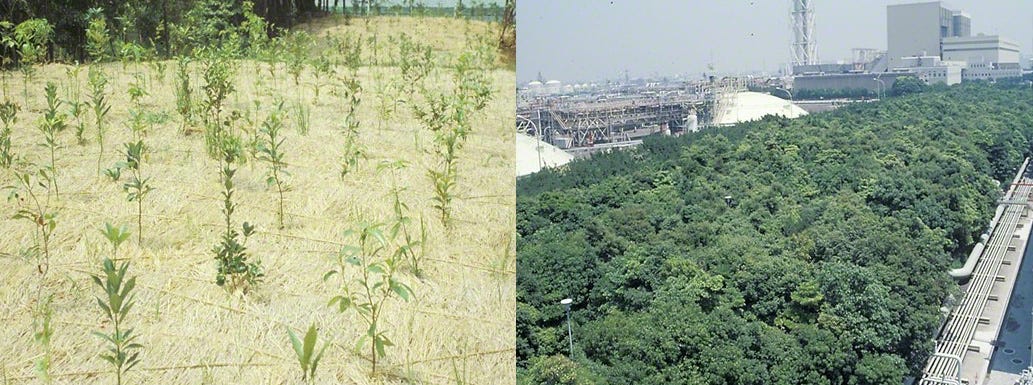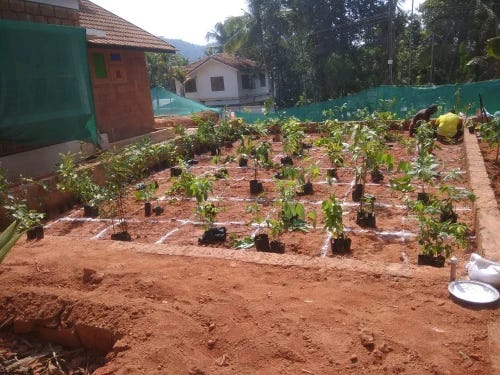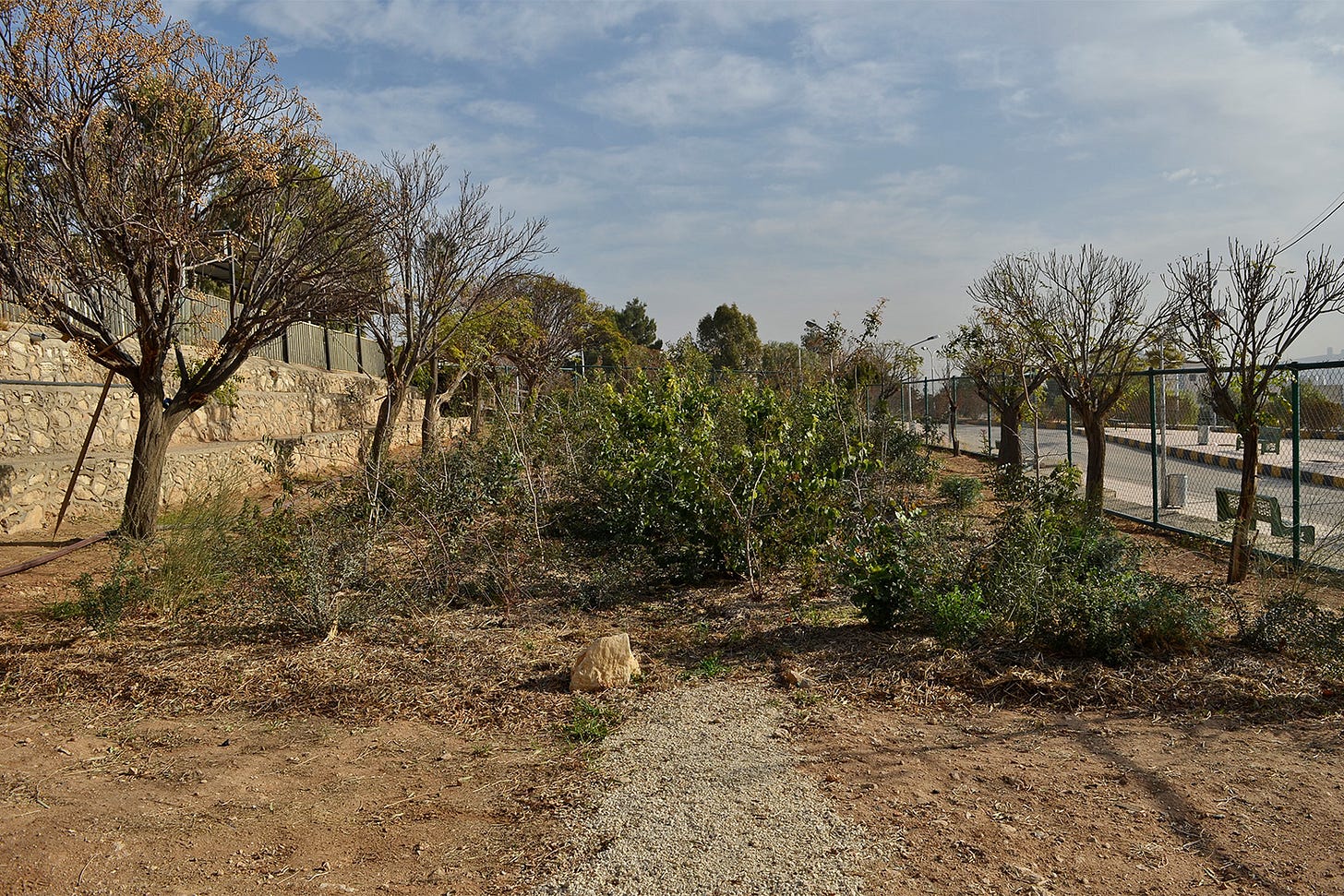One thing most people agree on is that one of the major challenges facing humanity today stems around the need to plant more forests. Nearly every major corporation offers some kind of gimmick of planting a free tree for some kind of donation, and while those aren’t exactly what we need, it points to a fundamental concern across politics. Today, we’re talking about a specific method of reforestation; we’re talking about the Miyawaki method, and a bit about its founder, Akira Miyawaki. While the method name probably doesn’t sound super familiar, the concept is pretty ubiquitous across YouTube in the rewilding space.
Before we can get into the method, let’s talk about the man behind the concept, Akira. We don’t know much about his early life, but he was born in Takahashi, Japan, which is in the southern part of Japan, and only 150 miles from where Fukuoka had been born 15 years prior, in 1928. That’s basically everything we know about his life before he was about 40.
By the 1970s, he began to advocate for natural forests. Now, what exactly did he define as natural forests? In his time as a botanist, he noticed that the tree species around temples, shrines, and cemeteries were longer-lived, slower-growing trees, and these sites, because of their religious significance, hadn’t faced the clear-cutting the rest of Japan had experienced. He concluded that all of the species we think of today as being native to Japan, largely the deciduous forest full of cedars, cypresses, and pines, were imported to produce timber. He’s also documented as saying that conifers that were introduced were naturally present at high altitudes and extreme environments, which we don’t think of today as being introduced species, so whether or not these species are non-native versus rather uncommon in the past because of land management practices is probably a conversation for folks more well-versed in Japanese ecology.
Regardless, he calculated that only .06% of forests in Japan were indigenous forests. He even suggested that because these were non-native forests, they were going to be incapable of addressing climate change in Japan. His solution was to look to the past and focus on a concept called Potential Natural Vegetation, also known as Kuchler potential vegetation, which was expanded by Reinhold Tuxen and focused on the concept that the more native, the better, and that if a site is native long enough, it would reach climax vegetation— the term used previously for old-growth. The idea was that native species have optimum ecological resilience for their native environment, and by proxy have the best potential to enhance biodiversity and meet the challenges of their specific ecotype.
Miyawaki believed that PNV was crucial for developing successful forests. Which, on one hand, is pretty valid when we think about the current state he’s talking about, less than 1% being indigenous. So he went to those sacred places and collected a bunch of seeds to build a seed bank for future forests. Unsurprisingly, people weren’t super happy about him taking seeds from sacred sites. He didn’t have much support. His first supporter came in the form of a company trying to do some PR— Nippon Steel. They had tried to create some forest embankments to deal with complaints and the first plantings had been an absolute failure.1 With the success of this project, Miyawaki was able to use the experience to spearhead hundreds of projects across the country, and later in life, internationally.2
While Miyawaki wrote an extensive collection on native vegetation to Japan, he also wrote a second book, The Healing Power of Forest- The philosophy behind healing earth’s balance with native trees, which is one of his only books available in English. This book is the philosophy behind his ideas and reinforces why he feels native plants are so important. So let’s take a look at how these projects compare to the typical “plant a tree” projects funded by companies in terms of success.
First, when we’re talking about projects with thousands of trees, success is a pretty relative term, so it’s hard to gauge, really, but depending on how they qualify success, it’s typically between 32 and 95%. Many projects in southeast Asia, where Miyawaki was most often working, or even in drier climates like the Mediterranean, show about 80% tree mortality at the decade mark.3 In 1999, nearly 30 years into doing these projects, Miyawaki wrote a research paper on his findings. In it, he summarizes the basic premise of his methods, as well as the results. Some of the stats he provides in this paper show that compared to 80% mortality in traditional reforestation projects, Miyawaki sites average around 40% mortality.4
That also doesn’t address some of the other benefits. But before we get there, let’s review the general methodology of designing and installing a Miyawaki forest. It’s fairly straightforward, to be honest. Start by assessing the greater region— not just where you’re looking to restore, but anywhere that might imply the ‘natural state’, again, thinking of our Germans and the concept of Potential Natural Vegetation, and have a clear outline of species in the vegetation and what could be there. Compare that with what’s on the site you’re looking to restore— are there some already on that site? Assess the soil, water, minerals, and so on to confirm that it’s a good site for those species. Identify which ones are keystone, and what species are often found nearby, and replicate those relationships in your planting. I’ll quote from Miyawaki:
When we see species combinations, we find high-fidelity species for particular communities. These species are called character species. We decide phytosociological units based on the character species. We compare phytosociological units widely from natural forests to secondary communities, and decide "associations", basic units of a plant community system, which can be applied to worldwide vegetation science. Likewise, we group the units into alliances, orders and classes by species combinations. In this way the hierarchical vegetation community system is decided.5
This comes with the obvious challenge of research. Specifically, thinking about how people stewarded landscapes before global economies allowed massive species shifts across the planet, and before landscapes were degraded with intensive agriculture. This is can be a challenge but resources are available online which can help guide what plants to consider, and using resources like INaturalist, we can find living specimens of these trees and there we can try to see how these species live in community to inform us of how to design these systems.
At this point, we’ve got the general species choices figured out, and how they’ll be clustered in a sense. From there, seeds are collected and started in a nursery, and once they’re 10-24” tall, they’re ready to be planted. This can take a few years, but that’s okay because the soil, if the site is degraded, which, if you’re restoring it—it probably is—needs some soil management. While you can’t restore 10 inches or more of topsoil that’s been washed away, mixing soil from the region with similar biology with fresh compost and wood chips is a great place to start. This can be improved by incorporating Soluable nutrients such as the ones we described when reviewing Korean Natural Farming or JADAM.
With the fresh soil down, we can plant our trees densely, 3 per square yard or so, if not more, typically with a companion cluster in each square. These companion clusters are usually designed with the stacking function from permaculture in mind, or rather, permaculture took this concept and tried to make it all food layers.
This stacking function is applied by centering the absolute tallest trees in the center of the forest, especially when it’s a smaller project, as these usually are. In the guilds themselves, they’re designed so that there’s a main cluster, the taller tree, and usually two shorter trees beside it, and then surrounding this are the lower canopy shrubs and so on. Often, these mounds are laid out and replicated to make organization easier and for shade to be distributed equally. Usually, these mounds are bordered by maintenance paths.
It’s important to think about how you’re going to water, weed, and so on for these sites. Mulching with straw will help reduce soil erosion and moisture loss, and for the following 2 to 3 years, weed removal, preferably through cutting—in order to reduce soil disturbance—will be required. By year 3, the canopy will begin to close in, reducing weeds. The other thing to keep in mind is the usage of an exterior ring of plants to help reduce nutrient runoff and reduce cold air blowing into the space. This area is called a fringe and mantle community, and it’s your transitional ecotone, typically around three feet or so and filled with taller grasses and forbs.
Miyawaki argues in his paper that quasi-natural forests can be formed in Japan in as little as 15 years, and 40 years in tropical places. He argues that wild natural forests in Japan without human intervention would take at least 150 years to develop, and he’s accelerating that process with dense planting in which the trees compete for sunlight and waste less energy with lateral branching.
An initial concern might be that this creates forests that are full of trees the same age. His argument is basically that as snags and breaks occur, secondary canopies will develop. It’s not expected that all of the trees survive, and it’s not even actually wanted. The idea is the healthiest trees survive, the others feed the soil, and again, coppicing species and openings in the canopy as trees die off over time will create a natural layering to the forest.
He also highlights the benefits of this planting method because of the cooperation between species. In contrast to the competition for sunlight, he argues that they equitably share the waters in the soil, and the general fitness of the trees is due to positive interactions between the trees.
Now, a few points that Miyawaki makes about these forests; he recommends not planting many if any of the primary stage species because they can often outcompete the slower growing, late-stage succession species, but if there are no resources otherwise, then to use them to keep the density high.6 The density is crucial here and super important in crowding out invasives, while also increasing the growth. In Malaysia, they compared tree growth between a regular site and the Miyawaki site; on traditional, trees grow at a pace of 20 cm/year over the five first years. Whereas Miyawaki tropical forests grow at a pace of 110 cm/year, a 550% increase in height.
To this point, we’ve hinted a bit that Miyawaki forests were originally designed for urban spaces, and I want to talk a bit about how accessible this is for the average reader. How small can these be? Well first, we know the benefits of greening urban landscapes, right? Air pollution, temperature regulation, water retention, species diversity, and sound pollution reductions are all benefits, never mind the mental health benefits. A 60-foot-wide Miyawaki forest has been documented to reduce sound pollution by 10 decibels within 10 years. 10 decibels increase in sound means something is 10x louder than before. That’s the difference between a chainsaw and a concert. Further, Miyawaki forests have shown diversity rates 18x higher than conventional forests.
The density of the small trees allows for better transfer of nutrients and water, between trees, increasing the success rate and also reinforcing those natural companionships that we had seen in those old-growth forests. By trying to support the fungal & bacterial community through the inoculated soils, those native soils we talked about, and planting trees closely together, so those underground networks are resources, they’re given the tools to be most successful. But to bring this all back to the question about how small these can be, some of these forests have been documented to be as small as 1,000 square feet, which is only like a 40 by 25-foot space.7
We’ve focused primarily on canopy trees, but these systems can be developed using shrubs, grasses, and small trees.8 This is an area that, despite Akira Miyawaki’s death, is continuing to be explored and refined. Shubhendu Sharma has been recognized as carrying the torch on Miyawaki’s methods, and he answers this to an extent and argues that since grasses are not typically a part of the old growth stage of a forest, they shouldn’t be included.9
I think the idea is that because trees have such a big impact on the site, those species naturally find their way into the understory. It’s important to recall if we’re talking about planting 40+ species of native trees, not all of those are going to be canopy trees, but will include understory and lower shrubs. And again, this isn’t painting with a broad brush in terms of the species make-up; it’s not just what *can* grow there, but what once likely did, specifically.
What this all comes down to is that building resiliency in our ecosystem requires we understand that ecosystem. Like, genuinely, not on a piece of paper but with hands-on experience. Restoring it can be as simple as spending time in the landscape, harvesting the seeds from the native species, growing them in planters, and restoring them into the landscape, which is particularly easy if the topsoil isn’t too degraded.
I think it’s important to recognize that despite the argument that these are supposed to be sites without human intervention, I’d disagree and say these landscapes were lightly guided by humans and will be going into the future.
If you’ve enjoyed this piece, which is equal to a 10-page chapter, of (so far) an 881-page book with 541 sources, you can support our work in a number of ways. The first is by sharing this article with folks you think would find it interesting. Second, you can listen to the audio version of this episode, #133, of the Poor Proles Almanac wherever you get your podcasts. Suppose you’d like to financially support the project, and get exclusive access to our limited paywalled content. In that case, you can become a paid subscriber on Substack or Patreon, which will both give you access to the paywalled content and in the case of Patreon, early access to the audio episodes as well.
https://yout u.be/_tJ_bH5JrIg
del Campo, A. D., Segura-Orenga, G., Bautista, I., Ceacero, C. J., González-Sanchis, M., Molina, A. J., & Hermoso, J. (2021). Assessing reforestation failure at the project scale: The margin for technical improvement under harsh conditions. A case study in a Mediterranean dryland. Science of The Total Environment, 796, 148952. https://doi.org/10.1016/j.scitotenv.2021.148952
Miyawaki, A. (1999a). Creative ecology: Restoration of native forests by native trees. Plant Biotechnology, 16(1), 15–25. https://doi.org/10.5511/plantbiotechnology.16.15
Miyawaki, A. (1999). Creative ecology: Restoration of native forests by native trees. Plant Biotechnology, 16(1), 15–25. https://doi.org/10.5511/plantbiotechnology.16.15
https://www.crowdforesting.org/minimum-size-of-a-miyawaki-forest
https://news.mongabay.com/2022/06/in-jordan-the-middle-easts-first-miyawaki-style-baby-forests-take-root/
https://timesofindia.indiatimes.com/home/education/news/shubhendu-clears-misconceptions-about-miyawaki-methodology/articleshow/70798962.cms











Do people include cropping trees in these plantings? Or is the purpose mainly ecological restoration?